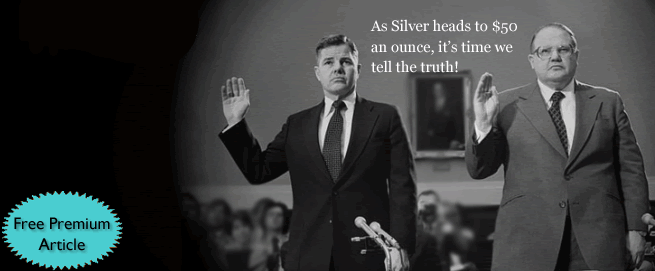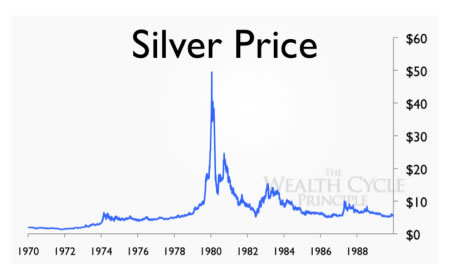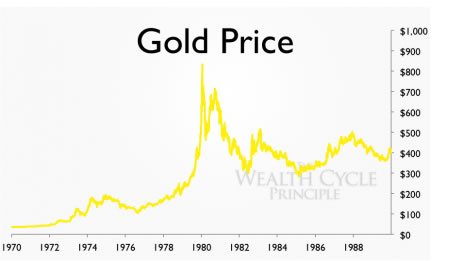Hunt Brothers $50 Silver Truth, How They Capped Gold…Yes, GOLD!
Commodities / Gold and Silver 2011 Apr 13, 2011 - 05:36 AM GMTBy: GoldSilver
 It began with a shoot-out at the Circle K Ranch. The 12 best marksmen would ride shotgun as the world’s largest, privately owned stockpile of silver was secretly transferred into secure vaults.
It began with a shoot-out at the Circle K Ranch. The 12 best marksmen would ride shotgun as the world’s largest, privately owned stockpile of silver was secretly transferred into secure vaults.
No, this wasn’t a shipment from Nevada’s Comstock Lode to San Francisco in the Wild West of the 1870s. This was the 1970s, and the precious metal was being moved from New York to Switzerland.
Shining silver under a moonlit sky, three unmarked 707s waited at LaGuardia Airport. The Circle K cowboys stood guard, shotguns in hand. 40 million ounces of bullion—amassed by Nelson Bunker and William Herbert Hunt—were loaded in, and the planes took off under cover of darkness to their secret destination…

Millions of people have heard the “official” story of how the larger-than-life Hunt brothers drove the price of silver from under $2 an ounce to over $50 in an attempt to corner the market. At one point, the two colorful Texas oilmen owned the rights to more than half the world’s silver supply. But then it all came crashing down on Silver Thursday, March 27, 1980, when silver fell to under $11 an ounce. Instead of making billions, the richest men in America ended up losing the bulk of their family’s fortune.
The Hunt Brothers—Sacrificial Lambs in Wolf’s Clothing
I’ve been studying the Hunt Brothers, and I have a different take on what really happened. Because of the way they flaunted their wealth, because of ties they had to the Middle East, and because they did invest so heavily in silver, the Hunt brothers were the perfect scapegoats for the anger and frustration most Americans felt towards the lagging economy of the day.
I believe that Bunker and his brother were used by the Federal Reserve, in collusion with COMEX and the Chicago Board of Trade (CBOT), to cap the price of gold—YES, GOLD—and save the U.S. dollar.

Inflation Indignation
The period leading up to silver’s spike was fraught with inflation, stagnant economic growth, and political upheaval. In 1965, President Johnson increased deficit spending to finance his Great Society programs, tax cuts, and an unpopular war in Vietnam.
In 1971, realizing that the U.S. Treasury didn’t have enough gold to redeem all the dollars held by foreign governments and investors, President Nixon pulled the United States off the Bretton Woods monetary system—the last vestiges of a pseudo gold standard. This action effectively created a worldwide fiat currency system that continues to this day.
OPEC-generated oil shortages, along with real food shortages, fueled public fears that the U.S. economy was in crisis. By the late 1970s, inflation had become public enemy number one.
The Hunt for Silver
The Hunt brothers could see the writing on the wall. With their great wealth being steadily eroded by skyrocketing inflation, they needed an asset to which they could safely anchor their massive oil fortune. At first, they thought of gold—history’s safe haven. But in 1973, U.S. citizens were not allowed to own gold, and Bunker Hunt thought the gold market was too easily manipulated for government purposes.1
So the Hunt Brothers turned to silver, and started buying it at about $2 an ounce. Total world silver production was dropping, while industrial silver consumption was exploding. And once government and private silver stocks ran out, the shortfall between supply and demand was certain to drive the price of silver skyward.
By early 1974, the Hunt brothers had purchased futures contracts (agreements to purchase commodities in the future at a pre-determined price) for another fifty-five million ounces of silver. This was on top of the massive hoard of physical silver they already owned.2 In April, Bunker Hunt stopped in New York to visit the COMEX trading floor for the first time. When he walked onto the floor, the normal frenzy of activity came to a screeching halt. Who was this fat Texan in thick plastic glasses and a cheap blue suit? Rumors began floating that the Hunt brothers were attempting to corner the market.
Those who believe that the Hunt brothers were out to corner the silver market point to Bunker and Herbert’s huge appetite for silver futures as proof that they were trying to manipulate prices. I see it a different way.
The Hunt brothers used their positions in silver futures to acquire more of the physical metal. Aware that cash was continually losing value due to inflation, they settled their futures contracts with physical delivery of bullion, instead of cash, as a hedge against the government currency monopoly and global turmoil.
I believe that the Hunt brothers were more concerned about long-term survival and preservation of their family’s wealth than they were with short-term speculative profits. That would merely have added a few more paper dollars to their vast sums of rapidly depreciating currency. Bunker Hunt was well versed in Germany’s disastrous hyperinflation of the early 1920s, and he was genuinely concerned about going broke holding paper assets.
In an interview with Barron’s financial magazine, Bunker kept quiet about his silver investments. But he made no secret of his distaste for the dollar: ‘‘Just about anything you buy, rather than paper, is better,” he said. “…If you don’t like gold, use silver, or diamonds or copper, but something. Any damn fool can run a printing press.”3
If You’re Losing, Change the Rules
By October 3, 1979, silver hit $17.88 an ounce.4 The two major U.S. exchanges, COMEX and CBOT, started to panic: They held a measly 120 million ounces of silver between them, an amount typically delivered in a busy month.5 With silver prices pushing to new heights as new buyers rushed in, the exchanges became fearful that a default (inability to deliver) was imminent.
The silver rush continued to accelerate, led by the Hunt brothers and their Saudi Arabian business partners. The Commodity Futures Trading Commission (CFTC), the government’s futures watchdog, had become seriously alarmed at the prospects of a shortage on the exchanges, and tried persuading Bunker Hunt to sell some of his silver.
The billionaire resisted, believing that silver was a long-term play with an integral role in the future global economy. The CBOT, backed by the CFTC, finally decided to put a stop to the Hunt brothers’ buying—by changing its rules.
Margin requirements were suddenly raised, and traders could hold no more than 3 million ounces of silver futures; those holding more were placed in forced liquidation. Bunker Hunt cried foul, accusing exchange board members of having a financial interest in the markets—an accusation that would later be proven true.
Then, the U.S. Federal Reserve and its chairman, Paul Volcker, added to the Hunt brothers’ troubles by strongly encouraging banks to stop making loans for speculative activity.
When Silver Sneezed, Gold Caught the Cold
On January 7, 1980, the other major U.S. exchange, COMEX, changed its rules also. Investors were limited to 10 million ounces in futures contracts, and any amount above that had to be liquidated by Friday, February 18.6 On the very next trading day, Monday, January 21, as silver reached a record high of $50 an ounce, the Hunt silver hoard peaked at a mind-boggling $4.5 billion, (that’s $43.5 billion in Shadowstats CPI-adjusted 2011 dolars!)5
On the same day that silver hit $50 and silver futures topped out at $52.50, gold’s price set a new record of $850 and gold futures peaked at $892. COMEX, terrified that it would be forced into default, announced—with the backing of the CFTC—that trading in silver would be limited to liquidation orders only, eliminating any buyers.
With no new buyers, the price of silver could not go up. So this rule was basically the same as saying, “Until this rule is lifted, the price of silver will only go down.” Of course, silver began to plummet, and on that same day so did gold.
Was it just a coincidence that gold and silver peaked at the same time?
Could it be that many large silver traders also held gold?
Wouldn’t the gold traders on the exchanges have known what happened to the silver traders and said to themselves, “Oh my God…if they can do that to silver, then gold is probably next”?

From Billions to Bust
On Silver Thursday, silver dropped from $15.80 to $10.80 an ounce. The stock market also crashed, fueled by rumors that the Hunt brothers would liquidate stocks in order to cover their silver losses. Because most of their silver bullion had been purchased at under $10 an ounce, the Hunts were still ahead of the game on their physical silver. But in the futures market, where their average purchase price was near $35 an ounce, it was a different story.
It became easy for the government to label the Hunt brothers as market manipulators—both in the court of law and in the easily swayed court of public opinion. Bunker Hunt filed for personal bankruptcy and was charged with trying to corner the silver market. He settled with the IRS for $90 million and was fined an additional $10 million by the CFTC.7
Why were the Hunt brothers torn down? Gold and silver are the canaries in the coal mine: Their spiking prices reflected the public’s loss of confidence in fiat currencies—like the U.S. dollar. So, the government and banking establishment had a vested interest in keeping gold and silver prices from exploding.
Do you think it’s possible that the Federal Reserve may have realized they could suppress the price of gold and save the dollar—while making it look like they were really protecting everyone by going after the Hunt brothers?
After scrutinizing the evidence, my conclusion is that the Hunt brothers were sacrificial lambs. The Hunt brothers broke no laws. The CFTC, COMEX and CBOT simply changed the rules in the middle of the game. And the U.S. government, eager to stop the rush to gold and silver that threatened the credibility of its own fiat currency, had no problem looking the other way.
Even Jeffrey M. Christian, Managing Director and founder of CPM Group and one of the world’s foremost authorities on the markets for precious metals, told me in an interview that he believed the Hunt brothers only added between 75¢ and $1.00 to the price of silver.
Silver Linings: What the Hunt Brothers Can Teach Us Today
The Hunt brothers got into trouble because they exposed themselves to a huge amount of risk through their leveraged investments. Leverage makes a bigger impact when you’re losing than it does when you’re winning: It can be as blunt as a bowling ball on the way up, but as sharp as a surgical laser on the way down.
In my view, there’s simply no substitute for physical ownership of your own gold and silver. This is especially important today, as we see the fiat currency system showing severe signs of instability.
Whether the Hunt brothers were victims of their own greed, the greed of board members on the exchanges, a desperate attempt by the Fed to save the dollar, or some combination of these things, it’s clear to me that the fall of silver in 1980 brought gold down with it and bought the dollar some extra time.
We have no way of knowing how high gold and silver would have gone if the government and banking establishment hadn’t gone after the Hunt brothers. We’ll never know if the dollar would have survived. We do know that gold peaked when silver peaked, and we know that gold fell when silver fell.
In the near future, both of these metals may again start taking off into the stratosphere. And this time, the Fed won’t have the Hunt brothers around to stop them.
- Mike Maloney
This is a free summary of the 2-part in-depth Hunt Brothers articles available to WealthCycles.com subscribers. Sign up for a free trial (no credit card or personal information required) to check out all the articles and analysis by Michael Maloney and the WealthCycles.com team.
Mike Maloney is the owner and founder of GoldSilver.com, an online precious metals dealership that specializes in delivery of gold and silver to a customer's doorstep, arranges for special secured storage, or for placement in one's IRA account. Additionally, GoldSilver.com provides invaluable research and commentary for its clients, assisting them in their wealth building endeavors.
© 2011 Copyright GoldSilver - All Rights Reserved Disclaimer: The above is a matter of opinion provided for general information purposes only and is not intended as investment advice. Information and analysis above are derived from sources and utilising methods believed to be reliable, but we cannot accept responsibility for any losses you may incur as a result of this analysis. Individuals should consult with their personal financial advisors.
© 2005-2022 http://www.MarketOracle.co.uk - The Market Oracle is a FREE Daily Financial Markets Analysis & Forecasting online publication.



